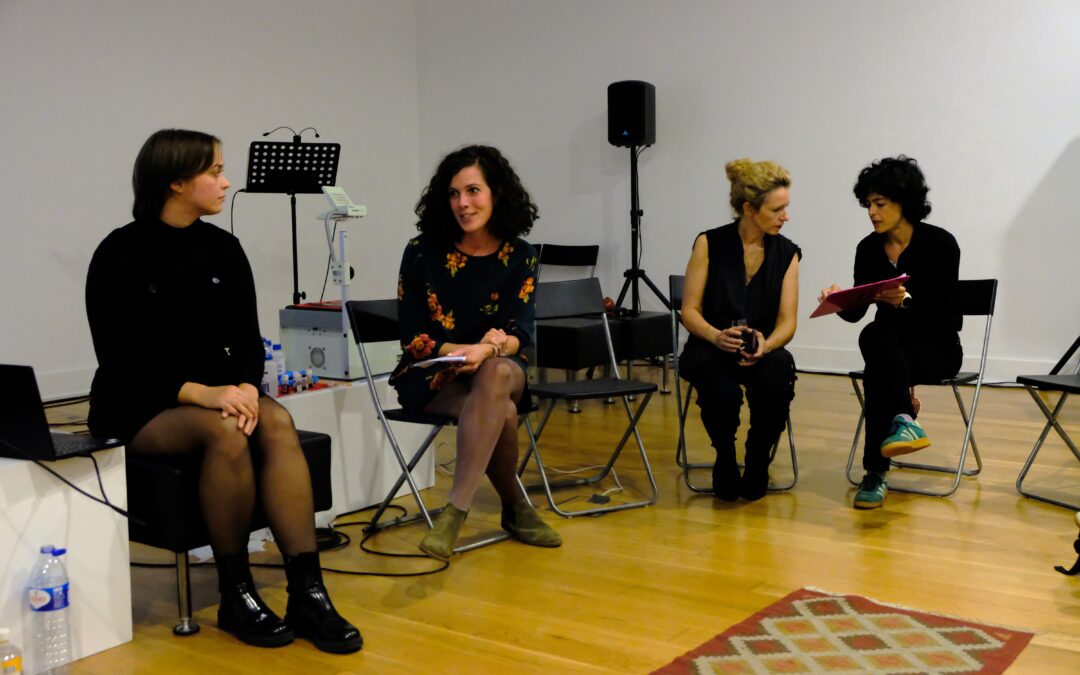PRODUCTION³ is a Creative Europe collaboration focused on developing new, research-informed approaches to audience engagement in the cultural sector. Led by the Valley of Arts Festival with Artemrede and ArtLink, the project brings together artists, hosts, and audiences to explore how cultural value can be co-created in more meaningful and sustainable ways. HÉTFA Research Institute serves as the project’s research partner, designing and conducting comparative studies across the participating countries to understand changing audience behaviours and expectations. This evidence-based foundation ensures that the artistic and organisational practices developed throughout PRODUCTION³ respond to real needs in a shifting cultural landscape.
On 22 October 2025 at 19:30, Palácio dos Anjos in Algés hosted an open evening performance of dis-place, following an earlier morning session dedicated to high school students. While the school session invited young people to explore the performance space and artistic process up close, the evening presentation welcomed a wider public – including visitors from Oeiras, members of the Artemrede network, local cultural professionals, and residents – creating a diverse audience with varied backgrounds and levels of familiarity with contemporary participatory art.
The dissemination event that followed was hosted by HÉTFA Research Institute, bringing together the project’s Serbian artists, Collective Studio 6, the Portuguese artists Marta Carreiras and Martim Rodrigues, the representatives of Artemrede, and members of the audience to reflect on the Serbian team’s performance and discuss insights from the wider PRODUCTION³ project.
The session began with a presentation of the preliminary findings from the audience research carried out across Hungary, Portugal, and Serbia by HÉTFA. The research explores how live cultural experiences are changing and what audiences value most today. Early results indicate that emotional resonance, meaning-making, and the opportunity to connect with relevant themes continue to play key roles in shaping cultural engagement. Participation is welcomed by many, but only when it is voluntary, clearly introduced, and allows each person to choose their level of involvement. For some, observing from a distance is meaningful in itself; for others, active engagement can deepen the artistic experience.
A roundtable discussion followed, focusing on how the performance was received and how dis-place evolved through interaction with different audiences. Members of Collective Studio 6 noted that while Serbia and Portugal represent different cultural contexts, the more significant difference came from generational perspectives: in Serbia, the audience included many acquaintances and mixed age groups, whereas in Portugal, the participants were largely teenagers and young adults. These contrasting dynamics influenced not only how the performance was perceived but also how participants engaged in the post-performance discussions or workshops.
Portuguese artists Marta and Martim highlighted the importance of the mentoring and collaborative structure provided by PRODUCTION³, emphasising how the project allowed space for experimentation and fostered closer professional and personal connections with the Artemrede municipalities. Representatives of Artemrede noted that the thematic depth of the productions – addressing topics such as mental health, displacement, and belonging – made the participatory approach particularly meaningful.
Across the discussion, participants agreed that there is no single or ideal level of participation. The strength of PRODUCTION³ lies in offering multiple entry points, from observing and reflecting to trying instruments, moving within the performance space, or contributing to shared moments of expression.
The event in Algés reflected the core aim of PRODUCTION³: to bring artists, cultural organisers, and audiences into closer dialogue, and to learn from the diverse ways people relate to art. As the project enters its final phase, the insights gathered will contribute to a comprehensive research report to be published at the end of 2025.
Photos: Paulo Martins, Artemrede

